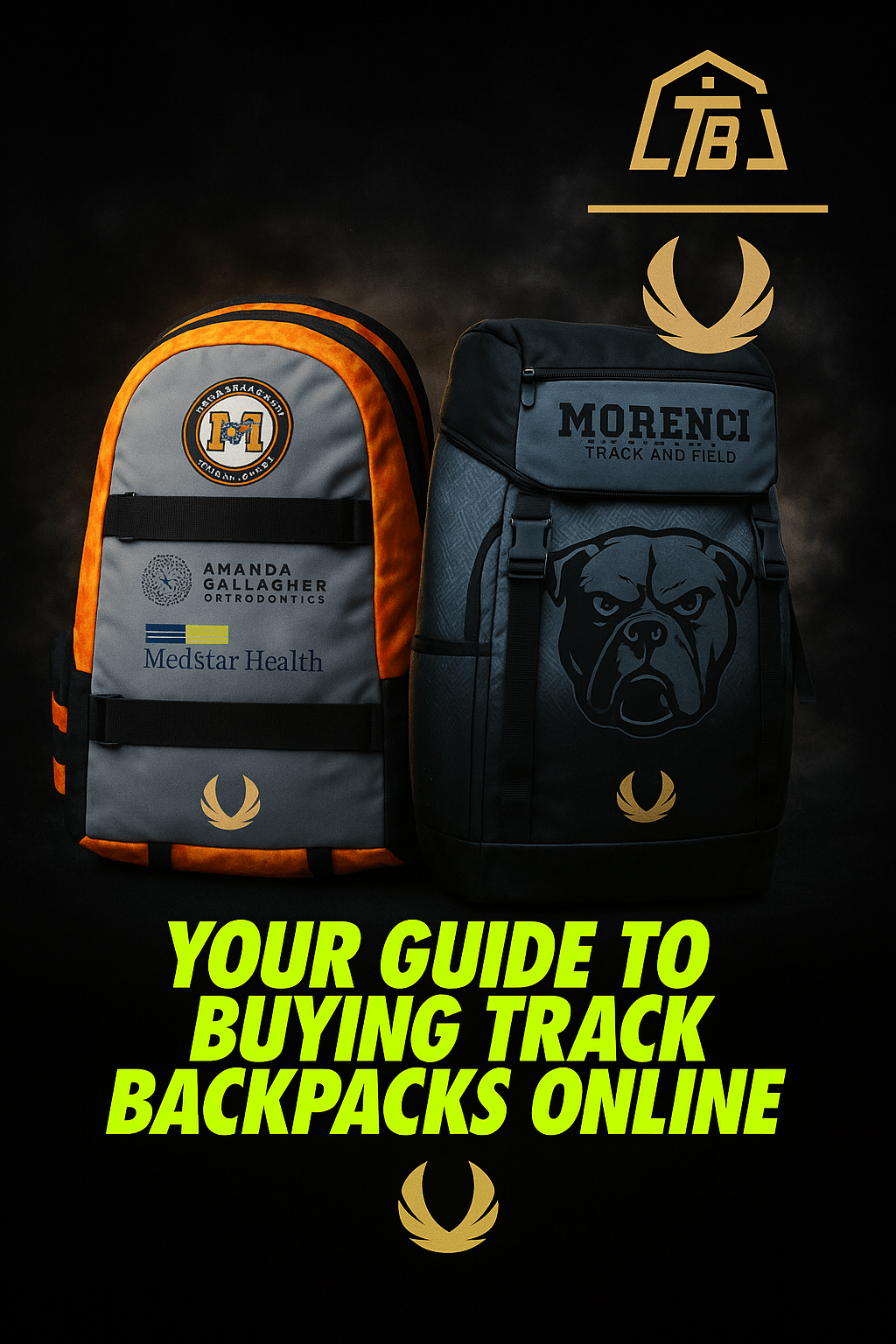The Ultimate Guide to Track and Field Backpacks: How to Choose the Best Track Backpack in 2025
Last Updated: June 2025 | 12 min read
Are you searching for the perfect track and field backpack that can handle your demanding training schedule? Whether you're a high school sprinter, college distance runner, or seasoned field athlete, finding the right track backpack can make or break your performance preparation. In this comprehensive guide, we'll explore everything you need to know about choosing the best track backpacks, featuring insights from TrackBarn's extensive collection of athlete-tested gear.
Why Track Athletes Need Specialized Backpacks
Track and field athletes have unique storage requirements that standard backpacks simply can't meet. Unlike regular school bags, track backpacks must accommodate specialized equipment while providing quick access during competitions and training sessions.
Essential Features Every Track Backpack Must Have
1. Multi-Compartment Organization
- Separate ventilated shoe compartments
- Waterproof sections for electronics
- Easy-access pockets for race-day essentials
- Dedicated hydration storage
2. Weather-Resistant Construction
- Water-resistant outer materials
- Reinforced stitching for durability
- UV protection for outdoor storage
3. Athlete-Focused Comfort
- Ergonomic shoulder straps with padding
- Breathable back panels
- Weight distribution technology
Top 5 Features to Look for in Track and Field Backpacks
1. Storage Capacity and Organization
The best track backpacks offer strategic compartmentalization rather than just large storage space. Look for:
- Shoe compartments: Ventilated sections that separate dirty spikes from clean gear
- Wet/dry separation: Waterproof compartments for sweaty clothes
- Equipment pockets: Padded sections for timing devices, phones, and valuables
- Nutrition storage: Easy-access pockets for energy bars and supplements
2. Durability for Year-Round Training
Track athletes train in all weather conditions, making durability non-negotiable. Premium track backpacks feature:
- Tear-resistant fabrics: Ripstop nylon or polyester construction
- Reinforced stress points: Double-stitched zippers and connection points
- Weather protection: Water-resistant coatings and sealed seams
3. Comfort During Transport
Nothing ruins pre-race preparation like shoulder pain from a poorly designed backpack. Essential comfort features include:
- Padded shoulder straps: Memory foam or gel padding
- Ergonomic back panel: Contoured design that follows spine curvature
- Load distribution: Internal frame or support system
- Breathable materials: Mesh panels to prevent sweat buildup
4. Quick Access Design
During competitions, every second counts. The best track backpacks offer:
- External pockets: For frequently used items
- Wide-opening main compartment: Easy gear visibility and access
- Zipper placement: Strategic positioning for one-handed operation
- Compression straps: Secure loose items during transport
5. Ventilation Systems
Track gear gets sweaty, and poor ventilation leads to odor and bacterial growth. Look for:
- Ventilated shoe compartments: Mesh panels or breathable fabrics
- Air circulation channels: Built-in airflow systems
- Antimicrobial treatments: Odor-resistant materials
- Removable gear bags: Machine-washable internal organizers
How to Choose the Right Size Track Backpack
Small Track Backpacks (20-30L)
Best for: Sprint events, field events, short training sessions
Ideal gear capacity:
- 1 pair track spikes
- Competition uniform
- Basic hydration
- Small towel and essentials
Medium Track Backpacks (30-45L)
Best for: Multi-event athletes, distance runners, full-day competitions
Ideal gear capacity:
- 2 pairs of shoes (spikes + trainers)
- Multiple uniforms
- Warm-up gear
- Full hydration system
- Recovery tools
Large Track Backpacks (45L+)
Best for: Multi-day competitions, team equipment managers, overnight travel
Ideal gear capacity:
- Complete gear sets
- Extra uniforms for teammates
- Coaching equipment
- Extended nutrition supplies
TrackBarn's Top-Rated Track Backpack Features
Innovative Storage Solutions
TrackBarn backpacks incorporate athlete-tested design elements that address real-world track and field challenges:
Specialized Compartments:
- Spike ventilation chambers: Separate airflow systems prevent odor transfer
- Electronics protection: Waterproof, padded sections for timing devices
- Hydration integration: Built-in bottle holders and hydration pack compatibility
- Uniform organization: Wrinkle-free storage for competition attire
Premium Materials and Construction
Weather-Resistant Technology:
- DWR coating: Durable Water Repellent treatment on all exterior fabrics
- Sealed seams: Waterproof construction at critical stress points
- UV protection: Fade-resistant materials for outdoor storage
- Abrasion resistance: Reinforcement in high-wear areas
Ergonomic Design Philosophy
Athlete Comfort Engineering:
- Load-bearing shoulder straps: Distribute weight across larger muscle groups
- Lumbar support panels: Maintain proper posture during transport
- Adjustability systems: Customize fit for different body types
- Ventilation channels: Reduce heat buildup against the back
Customization Options for Team Identity
Personalization Features
Individual Customization:
- Name embroidery: Permanent identification for team settings
- Number application: Match your competition bib number
- Color coordination: Team color combinations
- Logo placement: School or club branding options
Team Ordering Benefits:
- Bulk pricing: Volume discounts for team purchases
- Consistent branding: Unified team appearance
- Custom specifications: Tailored features for specific team needs
- Seasonal updates: Fresh designs for each competitive season
Maintenance Tips for Long-Lasting Performance
Regular Cleaning Protocol
Weekly Maintenance:
- Empty all compartments: Remove gear and debris
- Wipe interior surfaces: Use antimicrobial wipes in shoe compartments
- Check zippers: Lubricate and inspect for smooth operation
- Air dry thoroughly: Prevent moisture buildup
Monthly Deep Cleaning:
- Machine wash removable components: Follow care label instructions
- Spot clean exterior: Address stains and wear marks
- Inspect hardware: Check buckles, straps, and connection points
- Reproofing treatment: Reapply water-resistant coating if needed
Storage Best Practices
Off-Season Storage:
- Clean completely before long-term storage
- Store in dry location away from direct sunlight
- Maintain shape with packing materials
- Check periodically for pest or moisture issues
Investment Value: Why Quality Track Backpacks Pay Off
Long-Term Cost Analysis
Quality vs. Budget Comparison:
Premium Track Backpack ($80-150):
- Lifespan: 4-6 years of regular use
- Warranty coverage: Comprehensive protection
- Performance features: Specialized athlete functions
- Cost per year: $15-25
Budget Generic Backpack ($25-50):
- Lifespan: 1-2 years typical use
- Warranty coverage: Limited or none
- Performance features: Basic storage only
- Cost per year: $25-50
Performance Impact Benefits
Training Efficiency:
- Organized gear access: Faster preparation and setup
- Reliable equipment transport: No gear failures or damage
- Comfortable carrying: More energy for actual training
- Professional appearance: Confidence boost in competitive settings
Frequently Asked Questions About Track Backpacks
What size backpack do I need for track and field?
For most athletes, a 30-35L capacity provides optimal storage without excessive bulk. Sprinters and field event athletes can often use smaller 20-25L backpacks, while distance runners and multi-event athletes benefit from 35-45L capacity.
How important is waterproofing in a track backpack?
Water resistance is essential, full waterproofing is optional. Your backpack needs to protect electronics and spare clothes from rain, but complete submersion protection isn't typically necessary for track athletics.
Can I use a regular school backpack for track and field?
While possible, regular backpacks lack essential features track athletes need, such as ventilated shoe compartments, weather resistance, and sport-specific organization systems. The investment in a dedicated track backpack typically pays off in convenience and gear protection.
How often should I replace my track backpack?
Quality track backpacks typically last 3-5 years with regular use. Replace your backpack when zippers fail consistently, fabric shows significant wear, or comfort features no longer provide adequate support.
What's the difference between track backpacks and running backpacks?
Track backpacks emphasize storage and organization for competition gear, while running backpacks focus on lightweight hydration and minimal carrying during actual running. Track athletes need both storage capacity and quick access features.
Conclusion: Invest in Your Athletic Success
Choosing the right track and field backpack is an investment in your athletic performance and daily convenience. The best track backpacks combine specialized storage solutions, weather-resistant construction, and athlete-focused comfort features that support your training goals.
TrackBarn's curated selection of premium track backpacks offers the durability, functionality, and customization options serious athletes demand. With proper care and the right features, a quality track backpack becomes an essential part of your competitive toolkit for years to come.
Ready to upgrade your gear storage? Explore TrackBarn's complete collection of track and field backpacks, featuring detailed specifications, customer reviews, and expert recommendations to help you find your perfect training companion.
Looking for more track and field gear guides? Check out our comprehensive reviews of track spikes, training equipment, and competition accessories to complete your athletic setup.
Tags: track backpack, track and field gear, athletic backpacks, TrackBarn, track equipment, sports backpacks, running gear storage

